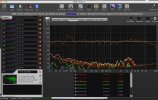Very cool! I'll respectfully decline the suggestion to wear headphones as my BACCHed system does a good job of reproducing binaural recordings. The room sound is very apparent here of course and gives a strong "you are there" sensation, although I'm not sure how we classify this under the term "soundstage".Yes, I agree it's hard to judge the distance to the drumset, but the main thing is that everyone should at least be able to hear that the recording has an amazing depth and three-dimensionality, mostly thanks to the drums that excites the whole room and at least give us an idea of the size of it.
The drums played on that record were recorded in Studio B at Electrical Audio in Chicago. It's a big room with a high ceiling and hard surfaces, perfect for very roomy sounds. When you got time, put your headphones on and watch this binaural walkaround from that room, it's pretty cool.
My favourite recordings are the 360 ones done with the eigenmike that let you steer the audio and video in real-time.

